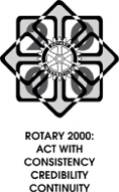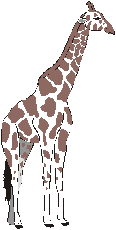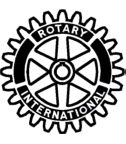


PROCEEDINGS
Rotary Institute
Zones 23 &
24
San Diego, California
Sam Greene, Director/Convener
Fourth
Plenary Session:
“Focus on Membership Development”
Mike
Kutsuris, Past Rotary International Director, chaired a panel discussion on
“Broadening Our Membership Base.” Panel
members were: George Prather, Juan Vargas, Danny Kim, and Director Sam
Greene. Kutsuris began the discussion with the assertion: “We cannot just
dream—it will be too late. We must act. Membership
must become a priority in every club and every district.”
Prather, a demographer and a Rotarian, provided
information on the areas of the population Rotary serves and the areas from
which we get our members. He showed us the age groupings in Rotary and how they
would change in the future if we do not find younger members.
He provided graphic detail on the changes in the US population that will
come about between 1995 and 2025. The
projections show that the White population will decline as a percentage in this
country from 73% to 61%, the Hispanic portion of our population will grow from
10% to 17% and the Black portion of the population will increase from 12% to
about 14%. The implications for
Rotary and any service organization are huge. (Editor’s
note: Getting more people from
the underrepresented groups of our population is key to being a vital and
relevant organization in the future The figures presented confirm that people in
Rotary are an older and rapidly aging group.)
“I think every club President’s job,” Prather said, “should be to
lower the club’s average age by five years!”
Vargas, a San Diego City Councilman, talked frankly
about race. He said people are
uncomfortable talking about race and yet the reality of race relations has to be
addressed by all groups—not just Rotary.
He said people feel more comfortable in their own group of people and he cited examples of how this has
worked with the Latino Chamber of Commerce in the San Diego area. The concern
was to benefit the ethnic group and the ethnic community rather that the whole.
He said Latinos like to be part of a group and that clubs with large
Latino membership could nurture Latino business and professional people who
might then move on into other Rotary clubs.
Kim, a member of the Koreatown Rotary Club in Los
Angeles, told how the Koreatown club was founded as a means of bringing Korean
business and professional people together in a comfortable atmosphere.
They are now recruiting second and third generation members.
Community service would not be in their area without the Rotary club, he
said. The club is now also at the
point where it wants to bring in other ethnic groups.
Previously it was not possible because of language barriers, but it now
can happen as people in the club now have better English skills.
Sam Greene had a number of suggestions:
P Bring
in additional actives in membership classifications. Many club members may not be aware another person with their
classification can be brought into their club.
P Hold
seminars at large industry complexes to let them know what Rotary is and does in
order to recruit new members. He
cited an example that will happen soon in a major complex nearby.
PPPPPP
Mike Kutsuris introduced the
President-elect of Rotary
International Frank Devlyn of Mexico.
Devlyn shared some of his goals for the year, which commences July
1, 2000. A few of these are:
P Use proactive task forces instead of
committees of people in Rotary who “do things.” Cliff Dochterman
will be coordinating the work of the task forces.
P Use consultants (people in Rotary leadership)
who have the expertise to help with specific projects.
P Address world population concerns, especially
through literacy programs for and education of the girl child.
P Use the village banking concept to a greater
extent in underdeveloped countries.
P Develop and strengthen urban programs such as
those for children who live on the streets in cities in many parts of the world.
P Focus on job training programs for people
with disabilities.
P Launch a “sight savers” program to help
prevent blindness.
P Speed up disaster relief efforts by Rotary by
establishing regional “storehouses” for emergency supplies.
P Continue and strengthen our partnering with
other organizations as we have done with “Polio Plus.”
PPPPPP
Ann Parode, former chairperson
of the San Diego Community
Foundation addressed the session on “The Role of Community Foundations.”
Her purpose:
1.
Acquaint
Rotary leaders with community foundations and their potential as partners with
Rotary clubs and districts.
2.
Explain
the advantages of community foundations as an alternative to setting up club or
district foundations.
Parode presented a brief
history of community foundations and explained
some of the benefits:
P Rotary clubs or districts can utilize
community foundations to receive modest gifts without the expense and legal
hassle of setting up a non-profit foundation.
P Community foundations are close to almost
everyone. There are 523 in the
United States.
P Community foundations are set up to work
collaboratively with organizations such as Rotary.
P Community foundations have grant-making
expertise and can work together with Rotary on community problems.
P The fee the foundations charge groups such as
Rotary for accepting and holding funds is low (1% per year).
P Funds can be kept in a “field of interest
fund” such as “disadvantaged youth.”
These monies will then be only available for that specific purpose.
P Contributions from Rotary (including
reserves) are controlled by the Rotary club board and the funds earn interest
while they are “on deposit” for Rotary.
P Most foundations publish a catlog each year
that lists funds to which people are invited to contribute.
This brings on-going Rotary projects or campaigns to the attention of
individuals as well as estate planners, living trust lawyers, etc.
P Information is readily available about
community foundations in your telephone directory or on-line at www.cof.org.
PPPPPP
Jon Stillman, a Past District
Governor and member of the Foundation staff in Evanston, continued the
technology emphasis with a presentation on “Navigating Rotary’s Web
Sites.” With help from Rotarian
and Webmaster Harriet Schloer of District 5110 in Oregon, Stillman
took us online to the Rotary web page (www.rotary.org) and explained some of its
features:
P It is now possible to discover where clubs
meet anywhere in the world.
P You can download the forms you need.
P Downloading emblems and Rotary artwork of all
sorts is easy.
P You can download the donor recognition form
to present it on short notice.
Jon invited Rotarian leaders
who want to know more about the possibilities of web pages to check out the
District 5110 site at www.district5110.org
or contact Schloer at webmaster@district5110.org.
¦¦¦¦¦¦